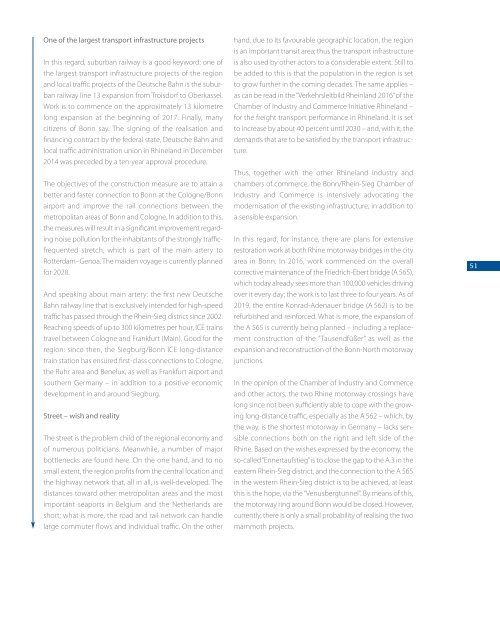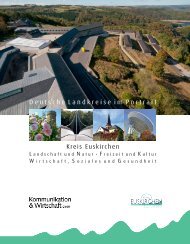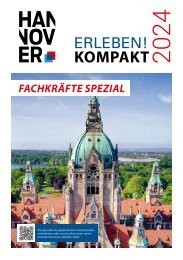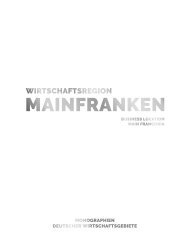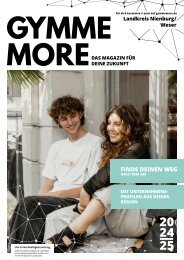Monographie Bonn-Rhein-Sieg
You also want an ePaper? Increase the reach of your titles
YUMPU automatically turns print PDFs into web optimized ePapers that Google loves.
One of the largest transport infrastructure projects<br />
In this regard, suburban railway is a good keyword: one of<br />
the largest transport infrastructure projects of the region<br />
and local traffic projects of the Deutsche Bahn is the suburban<br />
railway line 13 expansion from Troisdorf to Oberkassel.<br />
Work is to commence on the approximately 13 kilometre<br />
long expansion at the beginning of 2017. Finally, many<br />
citizens of <strong>Bonn</strong> say. The signing of the realisation and<br />
financing contract by the federal state, Deutsche Bahn and<br />
local traffic administration union in Rhineland in December<br />
2014 was preceded by a ten-year approval procedure.<br />
The objectives of the construction measure are to attain a<br />
better and faster connection to <strong>Bonn</strong> at the Cologne/<strong>Bonn</strong><br />
airport and improve the rail connections between the<br />
metropolitan areas of <strong>Bonn</strong> and Cologne. In addition to this,<br />
the measures will result in a significant improvement regarding<br />
noise pollution for the inhabitants of the strongly trafficfrequented<br />
stretch, which is part of the main artery to<br />
Rotterdam–Genoa. The maiden voyage is currently planned<br />
for 2028.<br />
And speaking about main artery: the first new Deutsche<br />
Bahn railway line that is exclusively intended for high-speed<br />
traffic has passed through the Rhein-<strong>Sieg</strong> district since 2002.<br />
Reaching speeds of up to 300 kilometres per hour, ICE trains<br />
travel between Cologne and Frankfurt (Main). Good for the<br />
region: since then, the <strong>Sieg</strong>burg/<strong>Bonn</strong> ICE long-distance<br />
train station has ensured first-class connections to Cologne,<br />
the Ruhr area and Benelux, as well as Frankfurt airport and<br />
southern Germany – in addition to a positive economic<br />
development in and around <strong>Sieg</strong>burg.<br />
Street – wish and reality<br />
The street is the problem child of the regional economy and<br />
of numerous politicians. Meanwhile, a number of major<br />
bottlenecks are found here. On the one hand, and to no<br />
small extent, the region profits from the central location and<br />
the highway network that, all in all, is well-developed. The<br />
distances toward other metropolitan areas and the most<br />
important seaports in Belgium and the Netherlands are<br />
short; what is more, the road and rail network can handle<br />
large commuter flows and individual traffic. On the other<br />
hand, due to its favourable geographic location, the region<br />
is an important transit area; thus the transport infrastructure<br />
is also used by other actors to a considerable extent. Still to<br />
be added to this is that the population in the region is set<br />
to grow further in the coming decades. The same applies –<br />
as can be read in the “Verkehrsleitbild Rheinland 2016” of the<br />
Chamber of Industry and Commerce Initiative Rhineland –<br />
for the freight transport performance in Rhineland. It is set<br />
to increase by about 40 percent until 2030 – and, with it, the<br />
demands that are to be satisfied by the transport infrastructure.<br />
Thus, together with the other Rhineland industry and<br />
chambers of commerce, the <strong>Bonn</strong>/Rhein-<strong>Sieg</strong> Chamber of<br />
Industry and Commerce is intensively advocating the<br />
modernisation of the existing infrastructure, in addition to<br />
a sensible expansion.<br />
In this regard, for instance, there are plans for extensive<br />
restoration work at both Rhine motorway bridges in the city<br />
area in <strong>Bonn</strong>. In 2016, work commenced on the overall<br />
corrective maintenance of the Friedrich-Ebert bridge (A 565),<br />
which today already sees more than 100,000 vehicles driving<br />
over it every day; the work is to last three to four years. As of<br />
2019, the entire Konrad-Adenauer bridge (A 562) is to be<br />
refurbished and reinforced. What is more, the expansion of<br />
the A 565 is currently being planned – including a replacement<br />
construction of the “Tausendfüßer” as well as the<br />
expansion and reconstruction of the <strong>Bonn</strong>-North motorway<br />
junctions.<br />
In the opinion of the Chamber of Industry and Commerce<br />
and other actors, the two Rhine motorway crossings have<br />
long since not been sufficiently able to cope with the growing<br />
long-distance traffic, especially as the A 562 – which, by<br />
the way, is the shortest motorway in Germany – lacks sen -<br />
sible connections both on the right and left side of the<br />
Rhine. Based on the wishes expressed by the economy, the<br />
so-called “Ennertaufstieg” is to close the gap to the A 3 in the<br />
eastern Rhein-<strong>Sieg</strong> district, and the connection to the A 565<br />
in the western Rhein-<strong>Sieg</strong> district is to be achieved, at least<br />
this is the hope, via the “Venusbergtunnel”. By means of this,<br />
the motorway ring around <strong>Bonn</strong> would be closed. However,<br />
currently, there is only a small probability of realising the two<br />
mammoth projects.<br />
51


